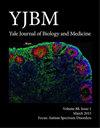尼日利亚一家三级医院男性症状性良性前列腺增生患者尿路感染的细菌学模式
IF 2.5
3区 工程技术
Q2 BIOLOGY
引用次数: 0
摘要
简介/背景:良性前列腺增生(BPH)的特点是前列腺尿道变窄,导致排尿困难、瘀血和易发生尿路感染。本研究的目的是确定尿路感染的患病率,分离的常见微生物,它们的抗菌药物敏感性模式,以及合并症与尿路感染的关系。材料和方法:纳入2020年1月至2021年1月期间所有以良性前列腺增生继发膀胱出口梗阻就诊的泌尿科团队患者。年龄、职业、合并症、尿液显微镜、培养和敏感性模式的信息获得并使用SPSS版本25进行分析。收集172例BPH患者的中游尿液样本。进行显微镜、培养和抗生素敏感性试验。结果:本组细菌尿率为67.9%,其中65 ~ 74岁和45 ~ 54岁细菌尿率最高和最低,分别为88.9%和33.3%。从他们的尿液中培养的最常见的微生物是假单胞菌(17.9%)、大肠杆菌(14.3%)、大肠菌群(10.7%)和克雷伯氏菌(10.7%)。这些微生物对氟喹诺酮类药物的敏感性最高(25.9%),其次是呋喃妥英(14.8%)和头孢曲松和头孢西丁(7.4%)。对Augmentin和庆大霉素的敏感性最低。结论:细菌性尿路在前列腺增生患者中较为常见。假单胞菌是本研究中最常见的分离菌,大多数分离菌对氟喹诺酮类药物敏感。本文章由计算机程序翻译,如有差异,请以英文原文为准。
Bacteriological pattern of urinary tract infection in men with symptomatic benign prostatic hyperplasia at a tertiary hospital in Nigeria
Introduction/Background: Benign Prostatic Hyperplasia (BPH) is characterized by narrowing of the prostatic urethra with resultant difficulty in passing urine, stasis, and a predisposition to urinary tract infection. The objective of this study is to identify the prevalence of urinary tract infections, common organisms isolated, their antimicrobial sensitivity pattern, and the relationship of co-morbidities with urinary tract infection in this population. Materials and methods: All patients who presented to our urology team with bladder outlet obstruction secondary to benign prostatic hyperplasia between January 2020 and January 2021 were included. Information on age, occupation, co-morbid conditions, urine microscopy, culture, and sensitivity patterns were obtained and analyzed using SPSS version 25. Midstream urine samples were collected from 172 BPH patients. Microscopy, culture, and antibiotic susceptibility tests were carried out. Results: From our study, the prevalence of bacteriuria was 67.9% with the 65-74 and 45-54 age groups having the highest and the least prevalence of bacteriuria (88.9% and 33.3% respectively). The most common organisms cultured from their urine were Pseudomonas (17.9%), E. coli (14.3%), Coliforms (10.7%), and Klebsiella (10.7%). Sensitivity patterns of these microorganisms revealed the highest sensitivity to the fluoroquinolones (25.9%) followed by Nitrofurantoin (14.8%) and Ceftriaxone and Cefoxitin (7.4%). The least sensitivity was to Augmentin and Gentamycin. Conclusion: Bacteriuria is common in patients with BPH. Pseudomonas spp was the commonest isolated organism in our study and most isolated organisms were susceptible to the fluoroquinolones.
求助全文
通过发布文献求助,成功后即可免费获取论文全文。
去求助
来源期刊

Yale Journal of Biology and Medicine
Biochemistry, Genetics and Molecular Biology-General Biochemistry,Genetics and Molecular Biology
CiteScore
5.00
自引率
0.00%
发文量
41
期刊介绍:
The Yale Journal of Biology and Medicine (YJBM) is a graduate and medical student-run, peer-reviewed, open-access journal dedicated to the publication of original research articles, scientific reviews, articles on medical history, personal perspectives on medicine, policy analyses, case reports, and symposia related to biomedical matters. YJBM is published quarterly and aims to publish articles of interest to both physicians and scientists. YJBM is and has been an internationally distributed journal with a long history of landmark articles. Our contributors feature a notable list of philosophers, statesmen, scientists, and physicians, including Ernst Cassirer, Harvey Cushing, Rene Dubos, Edward Kennedy, Donald Seldin, and Jack Strominger. Our Editorial Board consists of students and faculty members from Yale School of Medicine and Yale University Graduate School of Arts & Sciences. All manuscripts submitted to YJBM are first evaluated on the basis of scientific quality, originality, appropriateness, contribution to the field, and style. Suitable manuscripts are then subject to rigorous, fair, and rapid peer review.
 求助内容:
求助内容: 应助结果提醒方式:
应助结果提醒方式:


